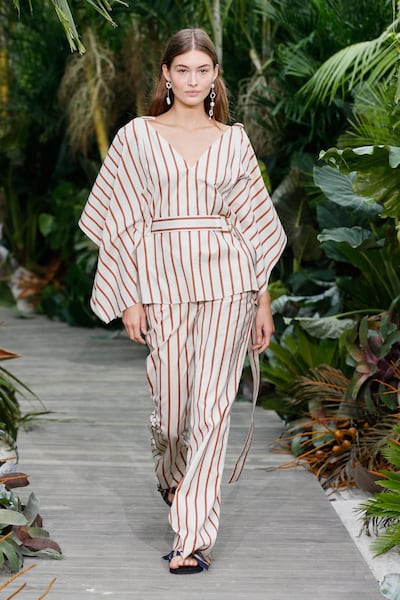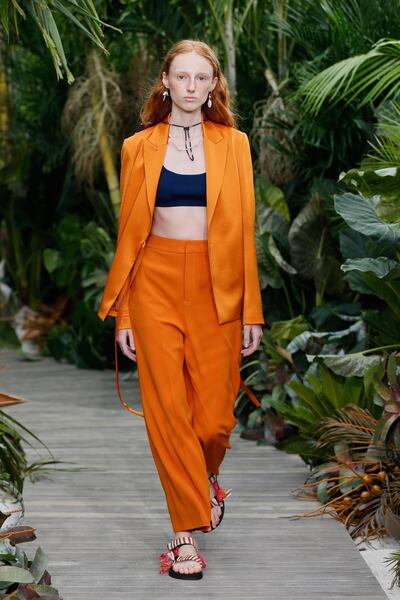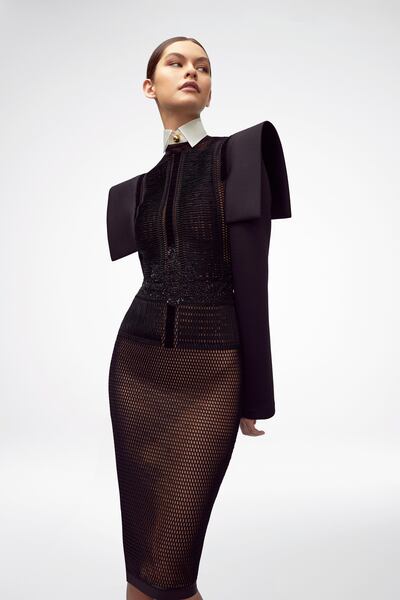Like most others things, Covid-19 has put pause on traditional expectations for the spring / summer 2021 round of New York Fashion Week, forcing designers to re-think and re-evaluate how best to relay the message behind each collection.
The varied responses it turns out, all mirror the adage that necessity is the mother of invention. Largely denied a live audience, brands instead have turned to other imaginative – and boisterously fun – ways to connect with its audience.
Jason Wu
At Jason Wu, who shot to fame as a favourite of former US first lady Michelle Obama, the reply to the grim reality of the virus was to transport the audience to a tropical holiday. As one of the very few shows in front of actual people, the designer summoned languid summery evenings in Moroccan style striped jalabiyas, and loose, easy going trousers, in breezy blues and warm tones of hazy terracotta and sunset orange.
Imitation of Christ
The offbeat label Imitation of Christ was not able to stage its usual performance / fashion piece, but didn't let that hinders its imagination. Instead it enlisted local women skate boarders – refreshingly in all shapes and sizes – who tore around a skate park clad in sparkling quirky, elevated street wear.
Anna Sui
Anna Sui opted for a lookbook that explored the idea of lockdown and staying home, by echoing the famous 1930 Grant Wood painting, American Gothic. Now softened with butterflies and heart shaped windows, it set the scene for a collection of prettily whimsical prairie looks.
Batsheva
Batsheva, the label that pretty much kickstarted the whole oversized, tiered dress trend, stayed close to its DNA, this time with dresses in polka dot shoulder tie cropped dungerees and ribbon laced jumpers, shot on New York roof tops. The best takeaway from it all? The matching, fabric wrapped shoes and umbrella.
Rodarte
Another brand that saw the wisdom of sticking to a winning formula was Rodarte, that reworked its favourite 1940s inspiration into pretty patterned dresses, wiggle skirts in jaunty gingham, and puffed shoulders and crisp cuffs, all teamed with some seriously lovely floral headdresses.
Thakoon
Thakoon meanwhile opted for a different approach, re-emerging after lockdown as a totally new business model, selling direct to customers. Gone were the dresses the label made its name with, replaced with clothes for the new reality of working from home and comfort seeking. Laid back and simple, it worked.
Zero + Maria Cornejo
Zero + Maria Cornejo was another name to embrace the WFH aesthetic. With practical wearability at the core of the label already, now the layers are even looser, and the choice of surface more important. Shibori jackets came lightly padded and worn with knee length coat tops and roomy cigarette pants. And matching face masks, naturally.
Sukeina
Sukeina – a newcomer to the industry – shouted its arrival with some seriously sophisticated bodycon.
Textured knit fabrics were carved around the body, the different weights of cloth working to keep the look considered and tailored. Arched shoulder panels and rippling feathers lent a vaguely architectural air, as to did high necklines of starched dress collars, held closed with large, gold buttons.
Tomo Koizumi
Tomo Koizumi is such a dazzling new talent, Marc Jacobs lent his New York store to ensure it was part of the New York calendar. In typical fashion, undaunted by the lack of runway for this season, it took its frothy, crumpled dresses and shot them in a park in the designers native Tokyo. Huge bridal dresses spilled off ornamental bridges, and sheltered under tiny paper parasols. Best of all were the cropped versions, in tutti- fruiti ice cream colours.
















